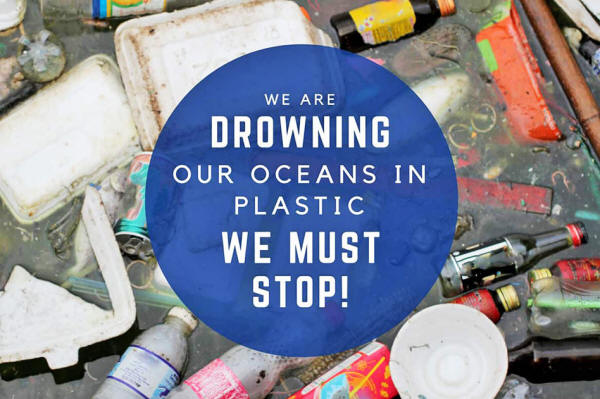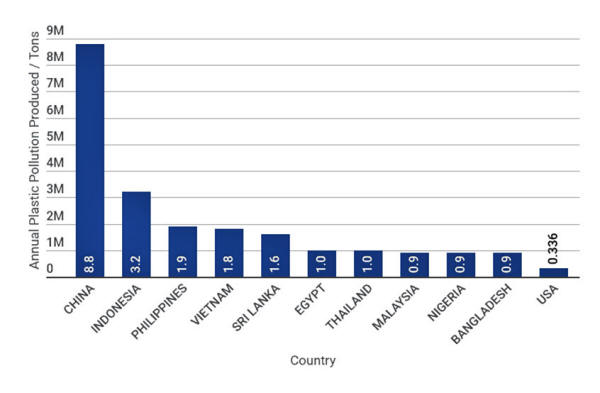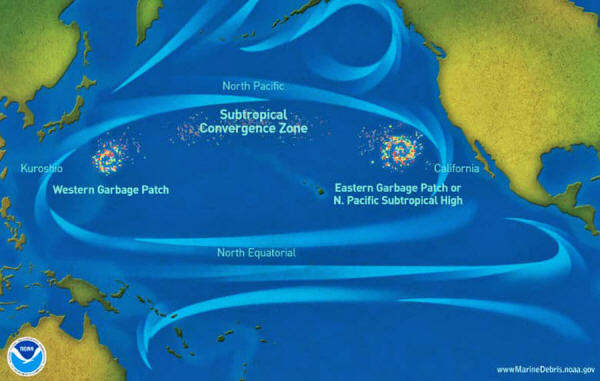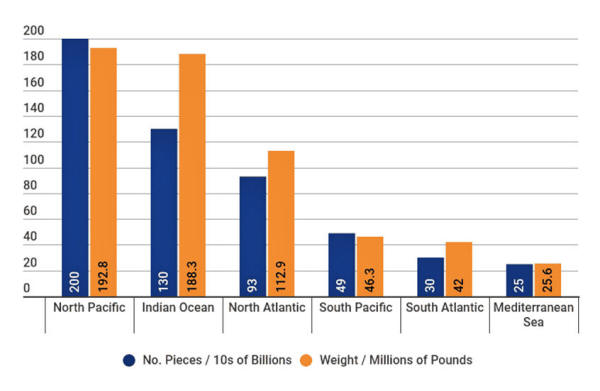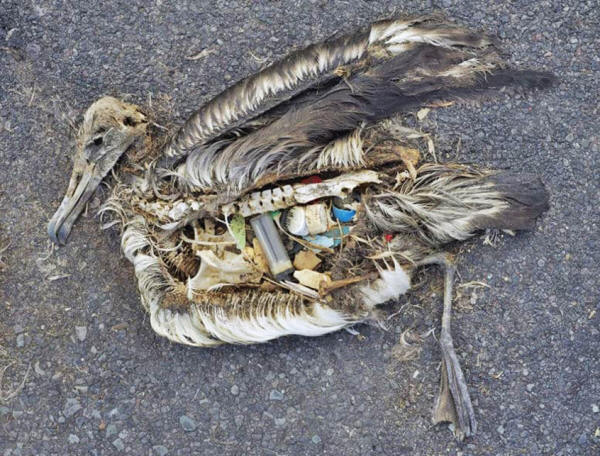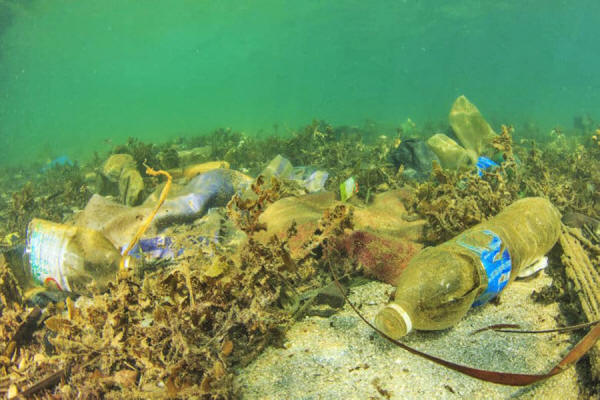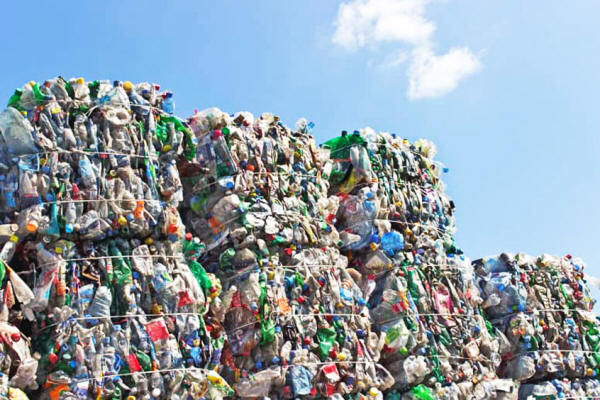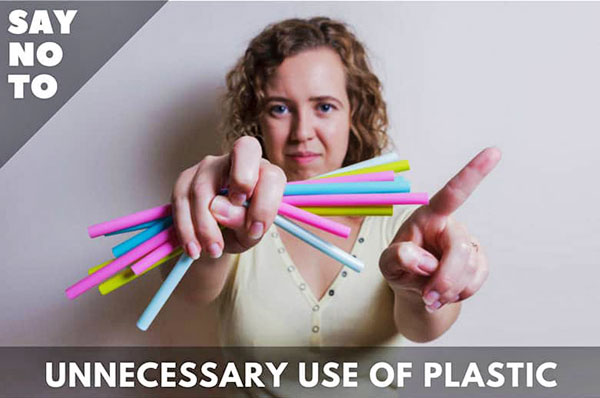|
from
ItsAFishThing Website
Close up of a ton of plastic
floating in the ocean.
For the other 60%, some of whom may
never have even seen an ocean, the seas still play a vital role in
their lives.
The scale of the problem
is enormous, but it's not a lost cause. Just like when your dentist
says you can avoid further problems with your gums if you brush
better and floss often, a change in how we live could be the
catalyst for cleaner oceans in the future.
They also last
a long time. Plastic breaks down very slowly.
When was the last time
any of you urban-dwellers went for a walk and didn't see a plastic
water bottle or grocery bag at the side of the road, or pressed up
against a fence?
Where Does All the Plastic In the Ocean Come From?
Scientists' best estimates are that 80% of the debris in the ocean comes from land-based activities.
The remainder comes from oilrigs, private boats, commercial ships losing cargo, and fishing vessels dropping nets and other gear.
The debris itself is comprised of everything plastic you can conceive of: automobile parts, toys, cigarette lighters, beverage bottles, and countless tiny pieces beyond identification.
While just about every country on the planet contributes to the problem, certain countries lead the way.
Here's a graphic of the top 10 annual global plastic polluters, also showing where the USA stands in relation, contributing 336,000 metric tons of plastic waste to the oceans every year:
Top 10 Global Plastic Polluters- And How the USA Compares -Data courtesy of
How Plastic
Garbage Ends Up in the Ocean
They
lack adequate collection, recycling, and disposal systems.
In a seldom-traveled area known as the North Pacific Subtropical Gyre, a convergence of currents has created what has since been dubbed the Great Pacific Garbage Patch.
By NOAA [Public domain]
How Big Is the Great Pacific Garbage Patch?
The Patch is comprised of two distinct patches, one closer to Japan, and the other between Hawaii and California. The eastern patch alone covers a surface area about the size of Texas or about 268,000 square miles.
Though you may be picturing a floating mound of trash, the reality is subtler than that, but perhaps more disturbing.
The Patch is more like a vast soup of debris, mostly comprised of microparticles of broken down plastics. While some of the plastic is visible, much of the heavier debris floats suspended down to a depth of several meters beneath the surface.
As if one giant garbage patch wasn't enough, there are also similar patches in each of the five gyres found in the Pacific, Atlantic and Indian oceans.
Between the five gyres and as of early 2015, there is an estimated 5.25 trillion pieces of plastic debris with a total weight of nearly 270 million tons.
The approximate distribution is as follows:
The Number of Piecesand Weight of Plastic Pollution in Each of the Oceans
Sources: VOX; Expert(s) (Eriksen, et al. 2014); PLOS
What Impact Does Plastic Have On the Oceans?
It goes without saying that plastic debris floating in the water is unsightly.
If you've ever been down to any urban harbor, you've probably seen it floating by the piers, and it looks nasty. But, apart from being visually unappealing, is plastic in the oceans really a big deal? After all, there's plenty of other stuff floating around out there.
All garbage in the oceans is bad, but plastics are especially toxic to the environment. Plastic in the ocean breaks down into small pieces because of exposure to the sun through a process called photodegradation.
In time, some plastics will degrade completely, but it can take decades, perhaps even centuries for even a simple plastic water bottle to fully disintegrate. Given the conditions in the ocean, it's possible that some plastics may never disappear entirely.
In the meantime, an estimated 1.9 million pieces of microplastics are fouling every square mile of the Garbage Patch.
While plastics deteriorate, they release hazardous chemicals into the water. Bisphenol-A (BPA), though less common in plastics today, was once found in most plastics.
BPA is believed to be carcinogenic and is linked to a number of other health concerns in humans.
Other hazardous chemicals found in plastics include:
On top of what is already a part of plastic's makeup, the material also adsorbs - meaning it attracts and holds on to other substances on a molecular and even atomic level - toxic chemicals like pesticides and PCBs.
It's like a bonus level of toxicity for anything unlucky enough to eat it.
Studies have further shown that plastic increases the likelihood of coral becoming diseased by as much as 89%.
As coral reefs provide habitat for over 25% of all marine life, this is very concerning.
Hungry Animals Are Eating Plastic
Unlike humans, marine animals can't always distinguish between plastic garbage and their natural food sources.
Small pellets of plastic may resemble plankton, bugs, and other food sources to fish. In fact, there may not be much else to eat in the Patch - plastic outweighs zooplankton by about 6 to 1.
Animals such as sea turtles and whales who dine on jellyfish frequently mistake plastic bags for their favorite meal.
And seabirds like albatross bring home plastic for their chicks to eat.
By Chris Jordan (via U.S. Fish and Wildlife Service Headquarters) CC BY 2.0 [CC BY 2.0 or Public domain]
Unfortunately, plastic doesn't just taste bad. It's also indigestible.
Animals who ingest large amounts of plastic end up with stomachs full of the stuff. Since it won't digest, they can't pass it through, and they are unable to eat anything else. Eventually, the poor creatures starve to death.
In one of the best-known and most tragic examples of this phenomenon, a dead Cuvier's beaked whale washed ashore in Norway in 2017.
An autopsy revealed 30 plastic bags stuck in its stomach.
The Problem of Plastics is Passed Through the Food Chain
While the unnecessary death of any animal is sad, there's a greater problem here than just the loss of a single marine life.
As noted earlier, plastics contain hazardous chemicals. These chemicals can make their way into the bloodstream and flesh of animals that ingest them. If another animal later eats that animal, the problem is passed along.
Even worse, as each successively larger predator consumes a toxic meal, the toxins concentrate in even greater amounts.
By the time the problem reaches the biggest predators, large amounts of toxins may be built up in their bodies.
Eventually, ocean-borne plastics can affect the entire food chain, even beyond the oceans themselves.
Because humans are at the top of the chain, we aren't immune to this issue. In fact, it all funnels toward us. Many species of fish commonly eaten by humans have been found to ingest microplastics at some point.
So much for the health benefits of "wild-caught" seafood!
Ghost Fishing
Fishing nets are a major component of marine plastic debris, accounting for as much as 46% of the total weight of the Great Pacific Garbage Patch.
Cut loose from trawlers and other fishing vessels, long nets drifting through the oceans continue to do their job of catching fish. This is what's known as "ghost fishing."
Not only are fish snagged in the nets, but also marine mammals, and even birds end up tangled.
According to one study, of the 120 marine mammal species currently on the "threatened" list, 54% have been found either snarled in nets or with plastic in their systems.
Plastic Garbage Isn't Limited to the Surface
© Richard Carey Adobe Stock
Scientists studying floating debris have discovered that approximately 70% of all marine garbage sinks to the bottom.
This does not mean the end of the problem, however. It just means it's been passed on to a different ecosystem.
Many marine organisms that live at or near the bottom of the seas rely on food that sinks down from above. Unfortunately, plastics are mixed in with the food, and it seems it's being ingested.
Creatures living nearly 7 miles (about 11km) beneath the surface in the Mariana Trench, the deepest point in the oceans, have been found with plastic in their digestive tracts.
Once plastic reaches the bottom, there's nowhere left for it to go.
It will contaminate the local food chain, just as it does at the surface. With limited currents and no sunlight, the breakdown of any plastic at the bottom might halt altogether.
Given the incredible difficulties and costs for ocean-bottom salvaging, it's likely that any plastic down there will stay there forever.
Looking for the Solution to the Plastic Problem
The scale of the plastic waste problem in our oceans is incomprehensibly vast.
Is it even possible to tackle an issue this big?
It has been suggested that any country that took on the challenge of cleaning up the Great Pacific Garbage Patch would bankrupt itself. And since it's out in the middle of International Waters, no countries are lining up for the job.
As reliable a source as the National Ocean and Atmospheric Administration estimated it would take 67 ships an entire year to scoop up less than 1% of the garbage in the North Pacific.
Despite the scope of the situation, there are those trying to do something about it.
Let's take a look now at what's being done about the plastic already in the ocean, and what can be done to stop it getting there in the first place.
Youthful Enthusiasm Is Taking On the Garbage Patch
Incredibly, one of the most promising potential solutions for cleaning the oceans was dreamed up by a 17-year-old young man from the Netherlands.
Today he's the head of The Ocean Cleanup, which staffs more than 70 people split between Delft, the Netherlands, and Alameda, California.
The Ocean Cleanup's plan is based on a free-floating, passive (non-powered) containment and collection system. It's designed to function autonomously, but with remote oversight.
The system is to be deployed in the Garbage Patch and gradually scaled up in size with multiple units drifting with the currents.
If a picture is worth a thousand words, that means a video is worth… umm… 30 frames per second, times 1:36… Forget it.
Have a look at this CG video to get an idea of how the technology works.
While the smallest microparticles may elude the system, the designers believe it will trap most waste from about 1/3 of an inch in size up to well over 100 feet.
Trapping larger pieces will prevent them from further breaking down.
Some of the smaller pieces missed will hopefully degrade entirely on their own.
Debris caught by the system is funneled towards a central collection platform where it's extracted and stored. Once full, a ship sails out to collect the waste and bring it back to shore.
The initial deployment hasn't happened yet, but a valuable test run in the North Sea in 2016 led to significant improvements to the design. The rollout of the first stage in the Pacific is planned for mid-2018.
Hopes are high for the project:
You can learn more about this amazing and ambitious project at their website.
There is even merchandise you can purchase to help support the cause.
What Happens To All The Plastic Taken Out of the Ocean?
The Ocean Cleanup's projection is the removal of up to 353,000 cubic feet of plastic every month.
What do you do with that much plastic?
Anyone with a municipal recycling program knows that some plastics can be recycled and some can't. Separating millions of tons of plastic, some of it very small, is just not practical, making it tough to recycle.
It turns out, however, that there are those who see value in this unnatural marine resource. Intact PET bottles and fishing nets are more easily removed and can be made into a variety of products from shoes to furniture.
It is hoped more buyers can be found for the harvest of plastic, with plastic sales helping to fund further clean up.
Stopping the Issue of Plastic Garbage at the Source
For most of us, someone comes and picks up our garbage and recycling weekly.
But are we garbage-free? No. We keep generating more garbage, and they keep coming to take it away in a never-ending cycle.
Even if it's successful, The Ocean Clean Up plan is essentially the same proposition. Cleaning up the plastic in the oceans is a noble pursuit, and of immense value to the environment.
But, it doesn't stop more plastic from hitting the surf. And it will.
Something needs to be done to stop the plastic from getting there in the first place.
Sailing To Glory On Garbage
In 2008, former US Marine, Dr. Marcus Eriksen, and his (then future) wife Anna Cummins built a raft out of 15,000 plastic water bottles, assorted bits of garbage, and the fuselage of a light airplane.
Dubbed JUNK Raft, Eriksen sailed it from California to Hawaii to help raise awareness about plastic in the ocean.
The following year, the pair founded the 5 Gyres Institute. The Institute is dedicated to preventing the problem before it becomes one.
Their surveys and studies of the gyres and their garbage patches have provided a lot of useful data. Perhaps more importantly, they've been actively working to find solutions for the plastics problem.
For example, part in thanks to their pressure, several large companies, including Proctor & Gamble and Johnson & Johnson, stopped using plastic microbeads in their products.
They've also helped fund projects aimed at repurposing plastic waste, so it becomes useful instead of trash.
Want to know more? Visit them online to see what they're doing, and what you can do to help.
Top 5 Ways to End the Problem of Plastics in the Oceans For Good
It's not realistic to imagine plastic is going to go away entirely.
It's too cheap and practical to ever get rid of unless someone invents something even better. Do you really think your next economy car is going to have a wooden dash?
What we can do, however, is minimize the impact of plastics. We can do that by rethinking how we make, use, and reuse plastic.
Here are some of the best ways to keep plastic out of the waste stream and the water.
We Are All At Fault - We Are All Responsible - We Can All Make A Difference
Removing all the plastic from the world's oceans is probably impossible.
What is possible is to stop more plastic from making its way there, and clean up as much as we can.
To do so will take a united and concerted effort, and not just from a few forward-thinking organizations. All individuals, companies, and governments need to play a role.
After all, the oceans belong to all of us, and all life on Earth depends on them.
When the oceans are sick, the planet is too.
Once you're truly aware of a problem, you can't ignore it any longer. Researching and writing this article was a genuine eye-opener for me. Hopefully, for you, reading it will have the same effect.
Then you can take those open eyes, look around you, and see the difference you can make.
Together, we can be the current of change that turns this whole issue into a distant, shameful memory.
|


